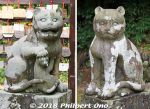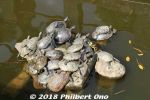Kyotango Kotohira Jinja Shrine 丹後峰山 金刀比羅神社
|
|
|

Established in 1811, Kotohira Jinja Shrine (nicknamed Konpira-san 金刀比羅神社) in Kyotango, Kyoto mainly worships Konpira (aka Kompira), the god who protects sailors, fishermen, ocean transport, navy personnel, and other seafaring people. People also pray here for business prosperity, family safety, scholastic excellence, safe childbirth, recovery from illness, and more. There are at least 30 Kotohira/Konpira Shinto shrines in Japan and the headquarters shrine is Kotohira-gu Shrine in Kotohira, Kagawa Prefecture in Shikoku.
|
|

This shrine in Mineyama, Kyotango greatly benefited from the patronage of rich, local Tango chirimen makers and it is unique for its koma-neko cat guardians.
|
|
|

Japan Heritage banner marking the 300th anniversary of Tango chirimen.
|
|

Kotohira Shrine's head priest Wakisaka Takuji (宮司 脇坂卓爾) explained it to us.
|
|

Kotohira Shrine has this unique affiliate shrine named "Kishima Shrine" (木島神社) which is the left half of this building. (The right-half shrine is Sarutahiko Shrine [猿田彦神社] for the god of transportation and directions.)Kishima Shrine is unique in Japan for these two koma-neko cat guardians. Shrines usually have koma-inu lion-dog guardians (to ward off evil spirits), but only this shrine in all of Japan has cat guardians instead.
|
|

Kishima Shrine has koma-neko cat guardians because silk farmers in the 19th century kept cats to protect their precious silkworms and cocoons from rats. Rats were a major problem for the silk industry.They ate the silk cocoons and worms. So cats saved the local silk industry.
The left cat is the mother (holding a kitten), and right cat is the father. Also respectively "A" and "un."
These koma-neko cat guardian statues were donated in 1832 by silk merchants and wholesalers such as the Tonomura family (外村家一族、岩滝のちりめん問屋、山家屋の小室利七) who were textile merchants from Higashi-Omi (Gokasho), Shiga Prefecture.狛猫
|
|

Koma-neko ema prayer tablet.
|
|

"Koma-neko Unique in Japan"
|
|

Back view of Koma-neko.
|
|
|

The left koma-neko cat is the mother (holding a kitten).
|
|

Koma-inu lion dog also protects the shrine.
|
|

Kotohira Shrine's Ema Hall (絵馬舎) used for prayers for safe seafaring. This hall had a large painting of the shrine’s grand float festival held about 100 years ago.
|
|

Sadly, most all of the 30 ornate festival floats were lost in the 1927 earthquake. Only this painting of the floats remains. Small little town like this to have this many ornate floats was very unusual. Thanks to the chirimen merchants. Such glory days are long gone though, as chirimen sales peaked long ago.
|
|

Kotohra Shrine's Haiden prayer hall.
|
|

Inside Haiden prayer hall.
|
|
|

Sorehouse for the shrine's festival float and mikoshi portable shrine.
|
|

Turtle pond.http://www.konpirasan.com/
|
|
|
|